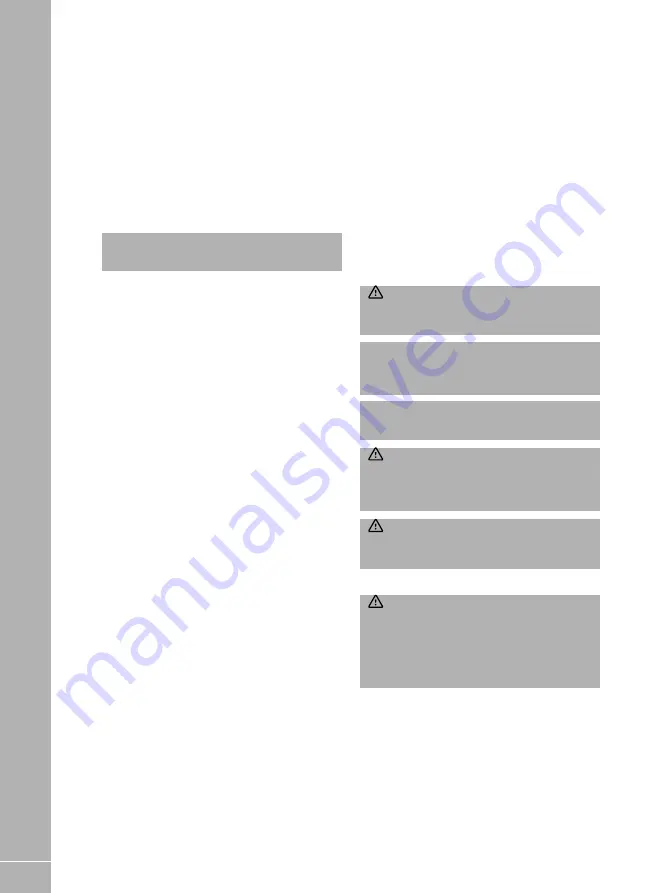
46
C
ONNE
C
T
IN
G SER
V
ICE
S
7.11 Types of gas
Propane
Propane is supplied in red, or partly red
cylinders which have a female left hand
threaded connector.
Scandinavian countries use the same connector.
Germany and Austria supply propane with a
male connection.
Propane will work at temperatures as low as
-40°C and is therefore suitable for all winter
motorhoming.
i
Note:
Swift recommend that 6kg Calor
propane gas bottles are used.
Butane
Butane is supplied in the U.K. in green or blue
cylinders.
All these have a male left hand thread
EXCEPT for Camping Gaz which has a special
female right hand thread and Calor 7kg and
aluminium bottles which have a special clip-on
connection.
Continental cylinders usually have a male left
hand thread similar to but not identical with U.K.
butane.
Butane is only suitable for use at temperatures
down to 2°C but will not work below that.
7.12 Changing a gas cylinder
Please use the correct size spanner for the gas
hose connectors as this will prevent damage to
the screw fittings and ensure that the fitting is
tightened sufficiently.
• Turn off gas appliances
• Close the empty gas cylinder’s valve
• Remove the high pressure hose from the gas
cylinder.
• Attach the high pressure hose to the full gas
cylinder.
• Open the full cylinder’s valve.
Check the hose connection to the cylinder valve
for leaks.
WARNING:
When
re-fueling your
campervan, switch off the heater and close the
cylinder valve.
i
Note:
Modifications, servicing and repairs
must only be carried out by a competent
service engineer.
i
Note:
The regulator should be replaced no
more than ten years after manufacture.
WARNING:
It is dangerous and illegal to
operate LPG appliances whilst travelling.
Service and repairs must only be carried out by
a competent service engineer.
WARNING:
Never allow modifications
or repairs of electrical or LPG systems and
appliances except by qualified persons.
Gas safety advice
WARNING:
If you smell gas or suspect a
leak or in the event of a fire and if it is safe to
do so, isolate the gas appliances and turn off
the gas bottles at the regulator. Evacuate the
campervan and ventilate. Seek professional
advice as to the cause of the leak.
Facts about LPG
• LPG is not poisonous.
• Bi-products are harmless.
• There is danger if all air and oxygen were
excluded.
• (Ventilation holes must be kept clear at all
times).
• LPG has been given a smell by the
manufacturers in order to identify leaks.
Summary of Contents for MONZA CAMPERVAN 2022
Page 1: ...SWIFTGROUP OWNER S HANDBOOK MONZACAMPERVAN IssuedApril2022 PartNo 1439878...
Page 3: ...2...
Page 5: ...4...
Page 27: ...26...
Page 28: ...27 4 En route 4 1Sparewheel 28 4 2Cruisecontrol 28 4 3Parkingsensors 28 EN R OU T E...
Page 34: ...33 AR R I VAL AT S I T E 6 Arrivalatsite 6 1Positioningthecampervan 34...
Page 45: ...44 C ONNEC T I NG S E R V IC E S 7 9GasSchematic...
Page 55: ...54 C ONNEC T I NG S E R V IC E S...
Page 63: ...62 E LEC T R I C AL S Y S T EMS...
Page 85: ...84 C AM P E R VAN C AR E...
Page 91: ...90 T ECHNI C AL I NF OR M AT ION 11 6Consumercircuitsfloorwithheater...
Page 92: ...91 T ECHNI C AL I NF OR M AT I ON 11 7Powercircuits...
Page 93: ...92 T ECHNI C AL I NF OR M AT ION 11 8Consumercircuitsroof...
Page 94: ...93 T ECHNI C AL I NF OR M AT I ON 11 9230Vcircuits...
Page 95: ...94 T ECHNI C AL I NF OR M AT ION 11 10Cablecolourchart...
Page 104: ...103...
Page 105: ...104...






























